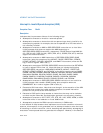
6-36 Vol. 3
INTERRUPT AND EXCEPTION HANDLING
Interrupt 7—Device Not Available Exception (#NM)
Exception Class Fault.
Description
Indicates one of the following things:
The device-not-available exception is generated by either of three conditions:
• The processor executed an x87 FPU floating-point instruction while the EM flag in
control register CR0 was set (1). See the paragraph below for the special case of
the WAIT/FWAIT instruction.
• The processor executed a WAIT/FWAIT instruction while the MP and TS flags of
register CR0 were set, regardless of the setting of the EM flag.
• The processor executed an x87 FPU, MMX, or SSE/SSE2/SSE3 instruction (with
the exception of MOVNTI, PAUSE, PREFETCHh, SFENCE, LFENCE, MFENCE, and
CLFLUSH) while the TS flag in control register CR0 was set and the EM flag is
clear.
The EM flag is set when the processor does not have an internal x87 FPU floating-
point unit. A device-not-available exception is then generated each time an x87 FPU
floating-point instruction is encountered, allowing an exception handler to call
floating-point instruction emulation routines.
The TS flag indicates that a context switch (task switch) has occurred since the last
time an x87 floating-point, MMX, or SSE/SSE2/SSE3 instruction was executed; but
that the context of the x87 FPU, XMM, and MXCSR registers were not saved. When
the TS flag is set and the EM flag is clear, the processor generates a device-not-avail
-
able exception each time an x87 floating-point, MMX, or SSE/SSE2/SSE3 instruction
is encountered (with the exception of the instructions listed above). The exception
handler can then save the context of the x87 FPU, XMM, and MXCSR registers before
it executes the instruction. See
Section 2.5, “Control Registers,” for more information
about the TS flag.
The MP flag in control register CR0 is used along with the TS flag to determine if WAIT
or FWAIT instructions should generate a device-not-available exception. It extends
the function of the TS flag to the WAIT and FWAIT instructions, giving the exception
handler an opportunity to save the context of the x87 FPU before the WAIT or FWAIT
instruction is executed. The MP flag is provided primarily for use with the Intel 286
and Intel386 DX processors. For programs running on the Pentium 4, Intel Xeon, P6
family, Pentium, or Intel486
DX processors, or the Intel 487 SX coprocessors, the MP
flag should always be set; for programs running on the Intel486 SX processor, the MP
flag should be clear.
Exception Error Code
None.


















